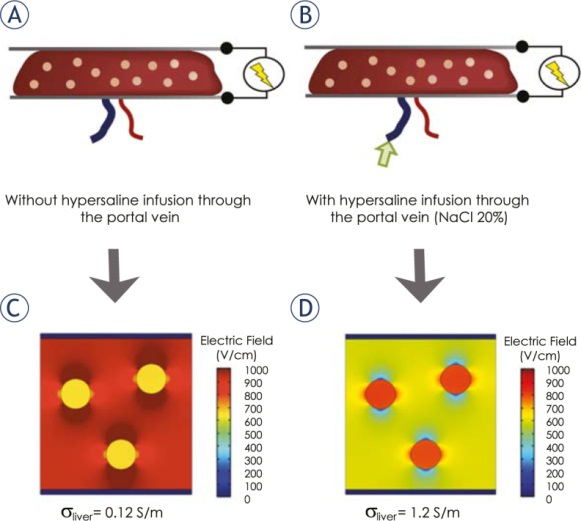
Hepatopancreaticobiliary tumours are often diagnosed at an advanced stage of the disease, when local bile or vascular structures have already been invaded, or there are distant metastases. Irreversible electroporation (IRE) is an emerging, image-guided tumour ablation technology that induces cell death by exposing the tumour to high-voltage electrical pulses between electrodes.
As it preserves the integrity of the surrounding tissues, IRE is an attractive treatment option for tumours located near vital structures. This technique has been used in our group's animal experimentation laboratory, as well as in the clinic, to treat liver (https://www.youtube.com/watch?v=dZEn0bAUggk) and pancreatic tumours that are in close proximity to vital structures.

Figura 1. IRE application model with plate electrodes, in tumoral liver either without (A) or with (B) hypersaline infusion through the portal vein and its corresponding numerical simulation (C and D) obtained from the electrical field received in healthy and tumour tissues. (C) With no hypersaline infusion through the portal vein, there is no selective effect on the scattered tumour nodules. However, in (D) with hypersaline infusion through the portal vein, the electric field is increased in scattered tumours (meaning the IRE has a preferential ablative effect on these nodules) due to the increased conductivity of healthy tissue (σ).
Unfortunately, the electrical conductivity difference between tumour and liver tissue hinders the selective IRE of tumour nodules. It is usually assumed that the conductivity of a liver tumour is higher than that of healthy tissue, therefore limiting the effect of this technique on the tumour. This conductivity differential between tumour tissue and healthy tissue can be reversed by injecting saline solution into the hepatic artery or portal vein, as the hepatic artery is the only blood supply for liver tumours.
Our group has demonstrated that by applying IRE, the electric field is significantly higher in scattered tumour nodules allowing them to be selectively removed while preserving healthy tissue. We have promising evidence that this change in conductivity could enhance the IRE's targeting of the tumour by protecting the healthy tissue. This is why it is being studied in a clinical trial
Important publications:
© Institut Hospital del Mar
d'Investigacions MèdiquesLegal Notice and Privacy Policy | Cookie Policy | Site Index | Accessibility | Find Us | Contact